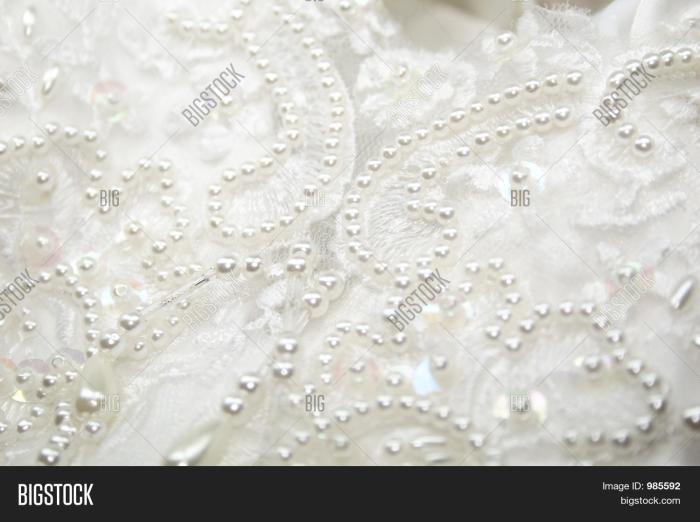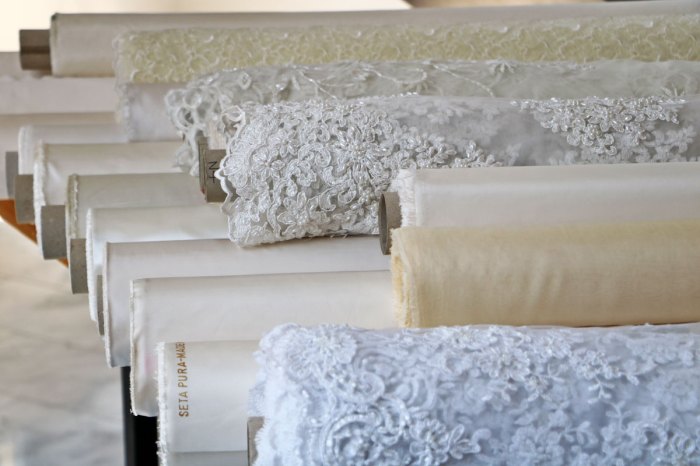Wedding Dress Fabrics: A Comprehensive Guide
Fabric for wedding dress – Choosing the perfect fabric for your wedding dress is a crucial step in creating your dream look. The fabric you select will significantly impact the overall style, comfort, and cost of your gown. This guide explores various fabrics, their properties, and how to make informed decisions based on your budget, season, venue, and personal style.
Types of Wedding Dress Fabrics

Source: bigstockphoto.com
This section details common wedding dress fabrics, examining their texture, drape, and suitability for various wedding styles. Understanding these characteristics will help you choose the ideal fabric for your gown.
| Fabric Name | Texture Description | Drape Characteristics | Suitability for Different Wedding Styles |
|---|---|---|---|
| Silk | Luxurious, smooth, and soft with a subtle sheen. | Flows beautifully, drapes elegantly, and holds its shape well. | Suitable for various styles, especially A-line, mermaid, and ballgown dresses. |
| Satin | Smooth, lustrous, and has a glossy sheen. | Drapes smoothly and creates a sleek, elegant look. | Ideal for sleek, modern silhouettes like sheath and mermaid dresses. |
| Lace | Delicate, intricate, and can range from lightweight to heavier depending on the design. | Drapes softly and adds texture and visual interest. | Adds romantic detail to various styles, especially A-line and ballgown dresses. |
| Tulle | Lightweight, sheer, and often used for layering or creating volume. | Drapes softly and creates a whimsical, airy feel. | Perfect for creating full skirts in ballgown and princess styles. |
| Chiffon | Lightweight, sheer, and has a slightly flowing texture. | Drapes softly and moves gracefully. | Suitable for romantic, flowing styles like A-line and empire waist dresses. |
| Organza | Stiff, sheer, and crisp with a slight sheen. | Holds its shape well and adds structure to the gown. | Often used for overlays or structured details in various styles. |
| Crepe | Slightly textured, matte, and drapes with a subtle ripple. | Creates a sophisticated, structured look. | Suitable for sheath, fit-and-flare, and A-line dresses. |
| Mikado | Heavyweight, crisp, and has a subtle sheen. | Holds its shape exceptionally well, creating a structured silhouette. | Ideal for creating strong, architectural shapes in various styles. |
| Charmeuse | Lightweight, luxurious silk with a lustrous sheen. | Drapes beautifully and creates a smooth, elegant silhouette. | Suitable for sleek, flowing styles such as A-line, mermaid, and sheath dresses. |
Silk, for instance, is known for its luxurious feel and elegant drape, making it ideal for a variety of silhouettes. Its weight varies depending on the type of silk, with heavier silks better suited for structured gowns and lighter silks perfect for flowing designs. Satin, on the other hand, is known for its glossy sheen and smooth drape, creating a sleek and modern look, particularly flattering in mermaid or sheath styles.
Lace adds a touch of romance and intricacy, working beautifully in A-line and ballgown designs. The airy lightness of chiffon lends itself to flowing A-line or empire waist dresses, while the structured stiffness of organza is perfect for creating architectural details. Finally, crepe’s subtle texture offers a sophisticated, structured look in sheath or fit-and-flare styles.
Fabric Selection Based on Season and Venue, Fabric for wedding dress

Source: newtess.com
The season and venue of your wedding significantly influence fabric choice. Consider the climate and ambiance when selecting your wedding dress fabric.
| Season | Venue | Suitable Fabrics | Reasons for Suitability |
|---|---|---|---|
| Spring | Outdoor Garden | Chiffon, Lace, Silk | Lightweight and breathable fabrics suitable for mild temperatures. |
| Summer | Beach | Cotton, Silk (Lightweight), Linen | Breathable fabrics that handle heat and humidity well. |
| Autumn | Church | Crepe, Satin, Mikado | More substantial fabrics that are appropriate for a formal setting. |
| Winter | Ballroom | Velvet, Brocade, Mikado | Heavier fabrics that offer warmth and elegance. |
Fabric Care and Maintenance
Proper care is essential to preserve your wedding dress. Understanding the specific needs of your chosen fabric will ensure its longevity.
Delicate fabrics like silk and lace require special attention. Dry cleaning is often recommended to prevent damage. Improper care can lead to discoloration, damage to delicate embellishments, and irreversible fabric damage. Professional cleaning and preservation services offer expertise in handling these delicate fabrics, extending the life of your dress. These services often include cleaning, pressing, and storage in acid-free archival boxes to protect against yellowing and deterioration.
Fabric Cost and Budget Considerations
Fabric costs vary widely. Balancing fabric cost with your overall wedding budget is crucial.
| Fabric | Price Range (Low-High) | Quality Considerations | Sourcing Information |
|---|---|---|---|
| Polyester | Low | Durable, affordable, but may lack the luxurious feel of natural fibers. | Widely available from various suppliers. |
| Silk | Mid-High | Luxurious, breathable, but price varies depending on quality and origin. | Consider sourcing from reputable silk producers known for ethical practices. |
| Lace | Mid-High | Price varies depending on intricacy and material. | Look for lace with sustainable certifications. |
| Tulle | Low-Mid | Affordable and versatile, quality can vary. | Consider suppliers that use recycled materials. |
Fabric and Wedding Dress Design
Fabric choice significantly influences the overall aesthetic of a wedding dress.
For example, a flowing A-line silhouette can be achieved using lightweight fabrics like chiffon or silk charmeuse, creating a romantic and ethereal look. A structured ballgown silhouette might utilize heavier fabrics such as Mikado or brocade, giving the dress a regal and dramatic appearance. The choice of fabric also impacts the embellishments that can be effectively used. Delicate lace complements intricate beading, while heavier fabrics may require bolder embellishments to create visual interest.
- Example 1: A simple sheath dress in crepe. Crepe’s subtle texture and structured drape create a sophisticated and modern look, ideal for a minimalist aesthetic.
- Example 2: A romantic ballgown in tulle. The airy nature of tulle creates volume and movement, ideal for a whimsical and fairytale-inspired design.
- Example 3: A classic A-line dress in silk. Silk’s luxurious drape and subtle sheen lend an elegant and timeless feel to the A-line silhouette.
Sustainable and Ethical Fabric Choices
Increasingly, brides are opting for eco-friendly and ethically sourced fabrics.
Organic cotton, recycled materials, and sustainably produced silk are gaining popularity. Choosing sustainable fabrics reduces the environmental impact of wedding dress production and supports ethical labor practices. Consider the environmental cost of different fabric production methods, such as water usage, energy consumption, and waste generation. Choosing sustainable fabrics minimizes your environmental footprint and aligns with ethical values.
Choosing the right fabric for a wedding dress is crucial; it impacts both the look and feel of the gown. The drape and texture of the material significantly contribute to the overall aesthetic. For instance, if you’re considering a vibrant and romantic design, you might explore options suitable for a colored floral wedding dress , perhaps a lightweight silk or a delicate lace.
Ultimately, the fabric selection will depend on the desired style and the season of the wedding.
Top FAQs: Fabric For Wedding Dress
Can I wear a heavy fabric like velvet in the summer?
While possible, heavy fabrics like velvet can be quite warm and uncomfortable in summer weather. Lighter fabrics like cotton or silk would be more suitable.
How do I determine the right fabric for my body type?
Flowing fabrics like chiffon or silk flatter most body types. Structured fabrics like brocade or taffeta can create a more defined silhouette. Consulting a bridal stylist can offer personalized advice.
What is the best way to preserve my wedding dress after the wedding?
Professional cleaning and preservation are highly recommended. This protects the fabric from damage and ensures the dress remains in pristine condition for years to come.
Are there any fabrics that are particularly prone to wrinkling?
Linen and silk can wrinkle more easily than other fabrics. Choose a fabric that aligns with your desired level of maintenance and consider professional steaming or pressing.